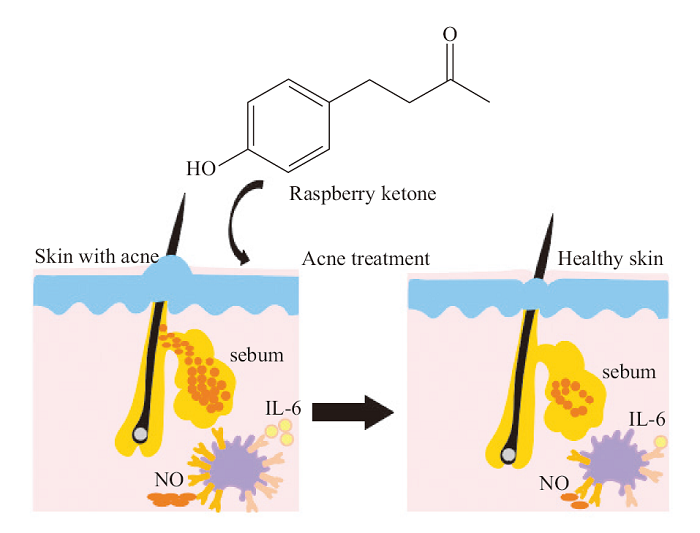Raspberry ketone (RK), a common ingredient in cosmetics, possesses antioxidant, preservative, and skin-whitening properties. However, the action mechanism of RK in the treatment of acne remains unclear. Therefore, the study evaluated the sebum-controlling and soothing efficacy of RK by establishing celluar models of lipid synthesis and inflammation in vitro. Additionally, a human efficacy testing on the acne-alleviating effects of RK was conducted. The results indicate that both low-dose (4 μg/mL) and high-dose (40 μg/mL) RK significantly decrease the synthesis of neutral and polar lipids. While the low concentration of RK at 4 μg/mL does not inhibit the secretion of interleukin-6 (IL-6) and nitric oxide (NO), the high concentration of 40 μg/mL significantly inhibits their expression with the inhibition rates of 39.5% and 20.7%, respectively. Additionally, compared with 100 μg/mL dexamethasone sodium phosphate (positive control group), RK at this concentration shows no significant difference in its inhibitory effect on NO secretion. In a trial involving volunteers who meet the inclusion criteria, after consecutively using cream samples containing 0.5% RK for 14 days, all participants report no adverse skin reactions. Notably, their sebum and porphyrin contents decrease by 23.0% and 22.5%, respectively. Furthermore, the lactic acid sting score, erythema index (EI) value, a* value in the red area, and red area size decrease by 48.8%, 6.1%, 11.3%, and 41.8%, respectively. The lesion regression rates for comedones, papules, and pustules are also reconfirmed at 33.8%, 41.8%, and 57.1%, respectively. Additionally, the height and volume of acne lesions decrease by 46.2% and 63.2%, respectively. The study demonstrates that RK exhibits sebum-controlling, soothing, and acne-reducing properties.



